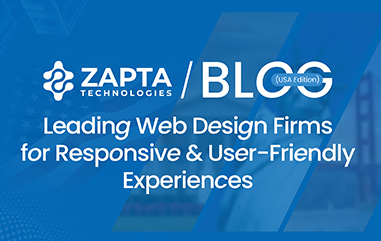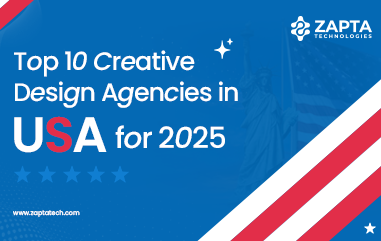Today’s users don’t just use apps they expect them to think.
They want interfaces that understand context, predict intent, and respond instantly. But most UIs? Still stuck in the past static, slow, and designed for a world that no longer exists.
Smart Interfaces in 2025: How AI Is Transforming Frontend Design
This article isn’t about futuristic hype. It’s about a real shift happening now: AI is moving into the front end, and it’s changing how we design, build, and experience interfaces. From smarter personalization to real-time adaptation, AI-embedded applications frontends are solving real user problems and quietly setting new standards for UX.
Why Today’s Interfaces Must Think Smarter
Let’s break down why this shift matters, what’s driving it, and how your interface can either evolve or fall behind.
Exponential growth of data and complexity demands intelligent synthesis
The apps and websites we use today handle way more data than they ever did. Think about all the clicks, searches, messages, and actions happening every second. That’s a lot for an interface to manage. If a user has to dig through too much information or options, it quickly gets frustrating. Slow or cluttered UIs make your users give up or switch to something easier. That’s why your UIs need to be smart. They use AI to sort through the noise and highlight what really matters for each user. For example, a finance app can spot important spending habits and show quick tips without making you dig through your whole transaction history.
When UIs help users make sense of complex data effortlessly, they complete their tasks quickly and stay satisfied with their experience. So as data grows, it's no longer enough for interfaces to just show information. They need to think a bit too.
User attention is scarce and fragmented, requiring frictionless experiences
To be honest, people don’t have the time or patience to figure out clunky apps. They’re juggling a hundred things, hopping between screens, and if your interface doesn't get to the point fast, they’re gone. A smart interface understands, instead of making users dig or think too much, it knows what they’re looking for and brings it forward. Think of it like a helpful assistant who hands you the right thing before you even ask.
Apps that do this well, like Spotify recommending the next song you’ll probably like or Google showing results before you finish typing, feel smooth, even addictive. That’s not magic, it’s AI reading the context and responding faster than the user can click away. In a world where attention is split across devices, apps, and notifications, the interfaces that earn user focus are the ones that act smart, not just look smart.
Dynamic contexts require adaptive, situationally relevant behaviour
Users don’t always interact with your app the same way. One day, they’re on a laptop at work, and the next, they’re on a phone in a noisy café. Their needs shift based on where they are, what they’re doing, and even how they’re feeling. That’s why interfaces can’t be one-size-fits-all anymore. Smart UIs adapt. They can switch modes, suggest actions, or change how information is shown based on what makes sense in that moment.
For example, a travel app might show flight updates as text at home, but switch to voice alerts when you’re driving to the airport. That’s not just a nice touch, it’s practical and it makes users feel understood. When interfaces adjust to the user’s real-life context, they stop being tools and start feeling like helpful companions.
Inclusivity and accessibility needs call for personalized adjustments
Not every user interacts with technology the same way. Some may rely on screen readers, others might speak different languages, or have trouble with small text and complex layouts. Smarter interfaces step in to bridge those gaps. With AI, apps can adjust on the fly, like switching to a simpler language, translating content, or even turning written instructions into voice guidance. This isn’t just about being nice to have. It's about making sure everyone can use your product comfortably and confidently. And when people feel included, they stick around longer. At the end of the day, smarter frontends don’t just make things easier, they make things fairer too.
Shift from command-driven to collaborative, predictive interaction
Old school interfaces wait for you to tell them what to do, click this, type that, press here, etc., but let’s face it, that kind of back and forth gets tiring. Today, users want systems that understand, not just respond. They want to say, “book me a cab”, and the app figures out the rest: location, time, preferences, without twenty extra steps. This shift from command-driven to conversational isn't just more convenient, it’s more human. AI makes this possible by picking up on context, past behaviour, and natural language.
Think of how you chat with voice assistants or ask ChatGPT questions, it's quick, natural, and feels like less work. That’s the direction the front-end needs to move in: less clicking, more understanding.
Real-time decision making and automation require on-the-spot intelligence
Some moments don’t give users the luxury of thinking twice, like tacking a package that’s about to be delivered or managing a fast-moving stock trade. In those cases, delays or slow updates can cause real frustration or even loss. Smart frontends use AI to react in real time. They don’t just show what’s happening; they help users respond instantly, whether that means sending a quick reply, flagging a risk, or suggesting the next best action.
Take ride-hailing apps, for example. They update routers and prices live, because anything slower would make the whole experience feel broken. That’s what modern users expect: interfaces that keep up and help out without lag. When decisions need to happen fast, the UI has to be one step ahead, not one step behind.
Competitive market pressure makes smarter interfaces a necessity
Users don't compare your app to just your competitor, they compare it to every great experience they’ve ever had. If your interface feels slow, clunky, or clueless, they’ll switch fast. That’s why smarter frontends make a difference and help you stay in the game. The brands winning right now, such as Netflix, Amazon, and Duolingo, are the ones that know what users need before they ask. They personalize, predict, and adapt. And behind all that, AI-powered interfaces are doing the heavy lifting. In crowded markets, it’s not about just what your app does; it’s about how easy and smart it feels to use. That’s what keeps users coming back.
Privacy-aware personalization via on-device AI enhances user trust.
Personalization is powerful, but it can also feel creepy if it’s not handled right. Users want smart experiences, not surveillance. This is where AI at the front end makes a real difference. With more intelligence built into the interface itself (think: on-device AI), apps can offer personalized suggestions without constantly sending data to the cloud. That means faster responses, less data sharing, and more user control. It’s a win-win: users get a tailored experience, and companies build trust instead of eroding it. Smart doesn’t have to mean invasive. Done right, it means being helpful and respectful.
Enabling generative and creative interactions needs AI-powered frontends
Users no longer interact with apps in just one way. Sometimes they type. Sometimes they speak. Other times, they tap, swipe, or even snap a photo. The line between input methods is blurring fast. Modern interfaces need to keep up. A truly smart UI UX design doesn’t just handle voice, text, or visuals; it blends them seamlessly based on what’s easiest at the moment. Think about asking your phone to search for a product you just took a photo of, or using voice to navigate while driving. It’s not about offering fancy features it’s about removing friction. The more naturally people can interact, the better the experience. And that’s exactly where AI-embedded frontends shine: adapting to how users want to engage, not forcing them to adjust.
That’s the shift
Interfaces need to think. Not in the abstract, futuristic sense but in the small, practical ways that make real interactions feel smoother, faster, and more human. And if that’s where users are headed, that’s where we need to be.

















